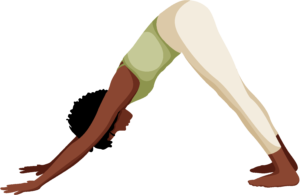Downward Facing Dog (Adho Mukha Svanasana)
Pose Overview
| Common Name | Downward Facing Dog |
| Traditional Sanskrit Name | Adho Mukha Svanasana |
| Sanskrit Name Pronunciation | ah-doh moo-kah shvan-ahs-ah-nuh |
| Pose Difficulty | Beginner |
| Drishti
Drishti is the gaze or visual focus point during yoga poses.
Learn more about Drishti |
Navel or between the legs |
Downward Facing Dog, or Adho Mukha Svanasana in Sanskrit, is a fundamental pose in many styles of yoga. It is considered a full-body pose, as it strengthens and stretches the entire body, from the hands and feet to the shoulders and back.
The pose gets its name from the fact that it resembles a dog stretching out, with the hands and feet on the ground and the hips reaching towards the sky. Downward Facing Dog is often used as a transition pose between other poses and is a common starting point for many vinyasa sequences. It is a great pose for stretching the hamstrings, shoulders, and spine, as well as strengthening the arms and legs.
Benefits of Downward Facing Dog
- Stretches the shoulders, hamstrings, calves, and hands
- Strengthens the arms and legs
- Calms the mind and relieves stress
- Improves digestion
- Relieves mild back pain
How to Enter Downward Facing Dog
- Start on your hands and knees, with your wrists under your shoulders and your knees under your hips.
- Tuck your toes under and lift your hips up and back, straightening your arms and legs.
- Keep your head between your arms, and press your heels down towards the floor.
- Hold for 5-10 breaths.
How to Exit Downward Facing Dog
Release the pose by bending your knees and coming back to your hands and knees.
Common Downward Facing Dog Modifications & Variations
- To make the pose less intense, bend your knees slightly to release tension in the hamstrings.
- To deepen the stretch in the shoulders, bring your hands closer together.
Common Mistakes with Downward Facing Dog
- Arching the back excessively, which can cause strain on the spine
- Not pressing the heels down towards the floor, which can cause strain in the legs
- Allowing the head to hang, which can cause strain in the neck
Safety Guidance
People with high blood pressure or carpal tunnel syndrome should avoid this pose or modify it with bent knees. If you have any wrist injuries, please should also be careful to keep the wrists in a neutral position and not to put too much weight on them.

